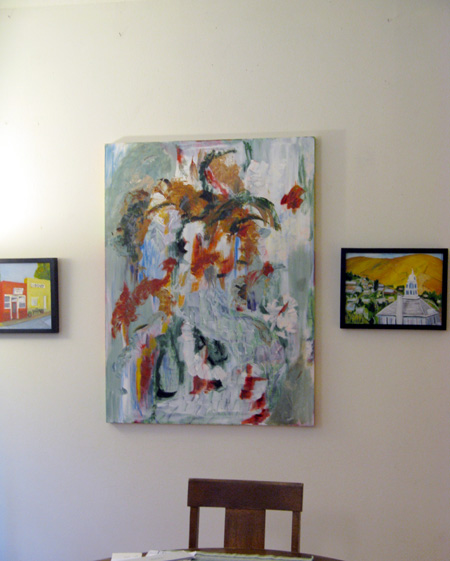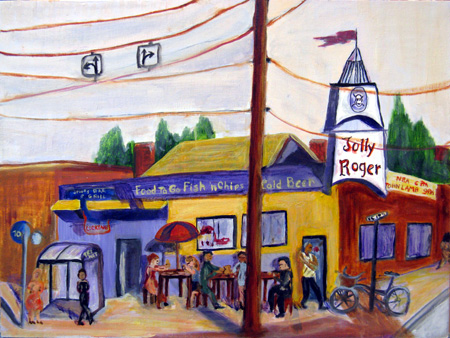Posted by June Underwood on December 12th, 2008
On Monday, I painted two plein aire oils from the uppermost level of a parking garage. On Tuesday I attended a crit session with some other painters that I meet with regularly. OF course, I showed them the paintings.
I managed to remember to photograph the first painting twice — once as it emerged from the garage session, and then again after I had been through the critique and had tweaked it in the studio. I didn’t do a lot to this painting in my second go-round, but when I finished I was concerned about the loss of some of the “naive” quality of the red building. Here are images of the two versions:

Library Parking Garage, View South (first draft) 12 x 16, oil on board more… »
Posted by June Underwood on November 30th, 2008
Across from my normal sitting place in our dining room (which is really our living/kitchen/common room) are some paintings –Frippery, 36 x 40″ oil on canvas, Condon Library (far left), and Heppner Courthouse, both 12 x 16 inches, oil on board.

more… »
Posted by June Underwood on November 16th, 2008

The Jolly Roger Bar, 12th and Madison. Oil on board, 12 x 16″
As you know, I’ve been painting around Portland, here and there, returning often to sites to note what else is there, what I may have missed, what more is available for turning into paint.
These paintings have a certain “feel” to them — a style that fits with the record of my visits. I work on-site and then tweak and fiddle in the studio. I also find myself making larger, stranger, studio-begot contributions to the sets of pieces.
more… »
Posted by June Underwood on October 31st, 2008
I am continuing to re- and re-read Schmid’s chapter on edges, because I’m not sure I have a decently full grasp of what he’s saying.
The book is Alla Prima: Everything I Know About Painting by Richard Schmid ($50 USD in soft cover from him; more from Amazon and more in hard cover).
Schmid begins his chapter by saying “Think about edges the way you would think about kissing someone…. Think of edges as exquisite subtleties, as the means to transmit romance, as ways to make your dabs or paint whisper or shout and reach nuances beyond the range of color. Think of them as visual poetry… but especially think of edges as you would the agents of expression in music….pianissimo (very soft), andante (flowing), allegro vivace (fast and lively), maestoso (majestic), fortissimo con sforzando (whamo!).
more… »
Posted by Steve Durbin on October 28th, 2008

Recent posts here on the topic of edges and their sharpness (or not) have been finding echoes in other places. For example, I’ve just read the intriguing but peculiar short story by Balzac, entitled The Unknown Masterpiece, which I learned of by reading that Picasso was asked to illustrate an edition. He (P) was apparently fascinated enough that he rented a studio in Paris thought to figure in the story; that’s where he painted Guernica.
more… »
Posted by Steve Durbin on September 24th, 2008

We’ve speculated here, there and elsewhere about the subliminal power of mental structures, such as the face-recognizing fusiform gyrus, to influence our perception of art and other visual experiences. So I was interested to see an article on the topic in the Toronto Globe and Mail (original story from Agence France-Presse), which was left at the hotel room on my last day in Newfoundland. It reports a study by Karl Grammer of the University of Vienna on how we react to cars on the basis of their “facial” characteristics.
more… »
Posted by June Underwood on July 25th, 2008
I’m back from the road trip, muddling about until my body decides it’s home.
Muddling about includes mulling over ideas, thoughts, notions, and niggles that life has handed me. Here’s a set of thoughts that I’ve maundered through in the last few days.
People, making conversation with the plein air worker, often ask “How long have you been painting?” My stock answer is “Oh, about 5 years.”
But I was cleaning up some old piles of stuff today, and ran across a whole covey of watercolors and acrylics that were dated 1999. Now my math is bad, but not that bad. Somehow time, or memory, had gotten short-circuited. I remember the class now; it was “painting the figure in watercolor,” and I stumbled into it by mistake, much, I suspect, to the horror of the very nice instructor.

Rosie, Winter, 1999, watercolor, 15 x 22″
more… »





